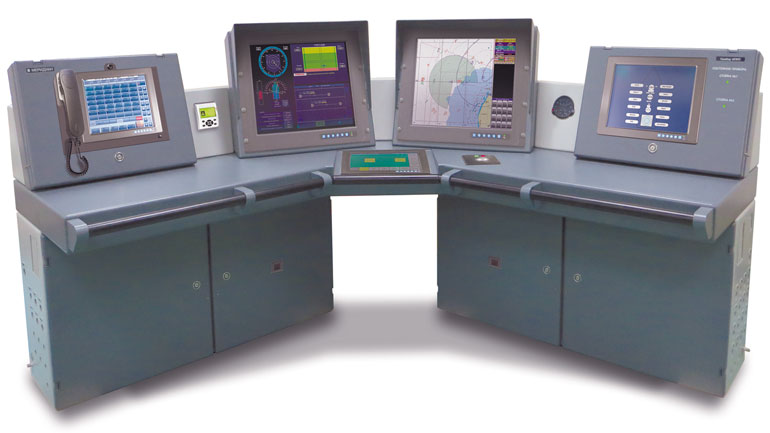
Integrated Flight Control Console (IFCC) installed at the Aircraft Controller’s post (ACP) can replace a large range of various-purpose equipment with different methods of data transmission, processing and display. IFCC console not only serves for reception, processing and display of data in operator-friendly form enabling him or her to deal with a larger volume of data but also generates recommendations for decision-making in a rapidly changing combat situation both in the air and on the ship’s flight deck.
Automated Helicopter (UAV)/ Helicopter (UAV) Group Flight and Landing Control System (AFCS) interacts closely with ship combat management system in real-time mode, which ensures safe flights and successful accomplishment of aircraft missions, as well as accurate and well-coordinated operation of all ship IFCC posts and stations in charge of flight control.
<strong>AFCS basic specifications</strong>
</p>
<div class="table-responsive">
<table class="table table-bordered">
<tbody>
<tr>
<td colspan="2">
<b><span style="color: #666666;">Main control unit / interface device</span></b>
</td>
</tr>
<tr style="background: #daf4fa;" valign="top">
<td style="text-align: left;" width="350px" valign="top">
Processor
</td>
<td style="text-align: left;" width="450px">
AMD 500 MHz
</td>
</tr>
<tr valign="top">
<td style="text-align: left;">
RAM
</td>
<td style="text-align: left;">
DDR SDRAM 256 Mb
</td>
</tr>
<tr style="background: #daf4fa;" valign="top">
<td style="text-align: left;">
ROM (Compact Flash)
</td>
<td style="text-align: left;">
4 Гб
</td>
</tr>
<tr valign="top">
<td style="text-align: left;">
Display
</td>
<td style="text-align: left;">
12’’ LCD color touchscreen with 800x600 resolution
</td>
</tr>
<tr valign="top">
<td colspan="2">
<br>
</td>
</tr>
<tr valign="top">
<td colspan="2">
Two data processing and display units
</td>
</tr>
<tr style="background: #daf4fa;" valign="top">
<td style="text-align: left;">
Processor
</td>
<td style="text-align: left;">
Intel 2,4 GHz
</td>
</tr>
<tr valign="top">
<td style="text-align: left;">
RAM
</td>
<td style="text-align: left;">
DDR3 SDRAM 4 Gb
</td>
</tr>
<tr style="background: #daf4fa;" valign="top">
<td style="text-align: left;">
Display
</td>
<td style="text-align: left;">
19’’ LCD color screen with 1280x1024 resolution
</td>
</tr>
<tr valign="top">
<td colspan="2">
<br>
</td>
</tr>
<tr valign="top">
<td colspan="2">
Data logging unit/video server
</td>
</tr>
<tr style="background: #daf4fa;" valign="top">
<td style="text-align: left;">
Processor
</td>
<td style="text-align: left;">
Intel 2,53 GHz
</td>
</tr>
<tr valign="top">
<td style="text-align: left;">
RAM
</td>
<td style="text-align: left;">
DDR3 SDRAM 4 Gb
</td>
</tr>
<tr style="background: #daf4fa;" valign="top">
<td style="text-align: left;">
ROM (SSD)
</td>
<td style="text-align: left;">
6 х 600 Gb/ 2 х 600 Gb
</td>
</tr>
</tbody>
</table>
</div>
At flight preparation, take-off and capture of air route, the system not only solves common tasks but can also assess the aircraft fitness to proceed to take-off depending on its status and environment parameters. It also plots and displays graphs showing sectors with safe course angles of take-off, departure from the ship’s vicinity and capture of air route.
During en-route flight, the system displays the designated route generating warning signals if monitored parameters exceed the preset limits or in case of near collision with other aerial objects and danger areas.
At flight deck approach and landing the system assesses the aircraft fitness to proceed to touchdown generating recommendations and signals if monitored parameters exceed critical values.
The system provides guidance to task group aircrews with a possibility to delimit their responsibility and transfer flight control from one ship to another. Three types of information can be displayed in any combination: primary and secondary radar information and cartographic information.
AFCS ensures full recording, storage and display of recorded information, as well as its output to external media. Such information includes commands and signals generated in the course of operation, aircraft flight parameters and data on the status of interfaced systems, tactical situation, information exchange via all communication channels and video information from surveillance cameras.
As part of ship armaments, the system performs the following key functions:
- Aircraft Controller’s (AC) information support and provision of all data necessary for him or her to perform their tasks during flight preparation, take-off, en-route flight, flight deck approach and landing;
- Communication between the ship’s posts and aircrews, as well as radio monitoring of main and standby control channels and ship homing radio station channels;
- Control of flight support equipment;
- Recording, storage and display of information on aircraft flight and AC’s actions;
- AC’s training in flight control
As part of AC’s information support, in any operation mode and at all flight control stages the system displays the following:
AFCS can be used at all the stages of aircraft control including preparation, take-off, en-route flight and landing.

